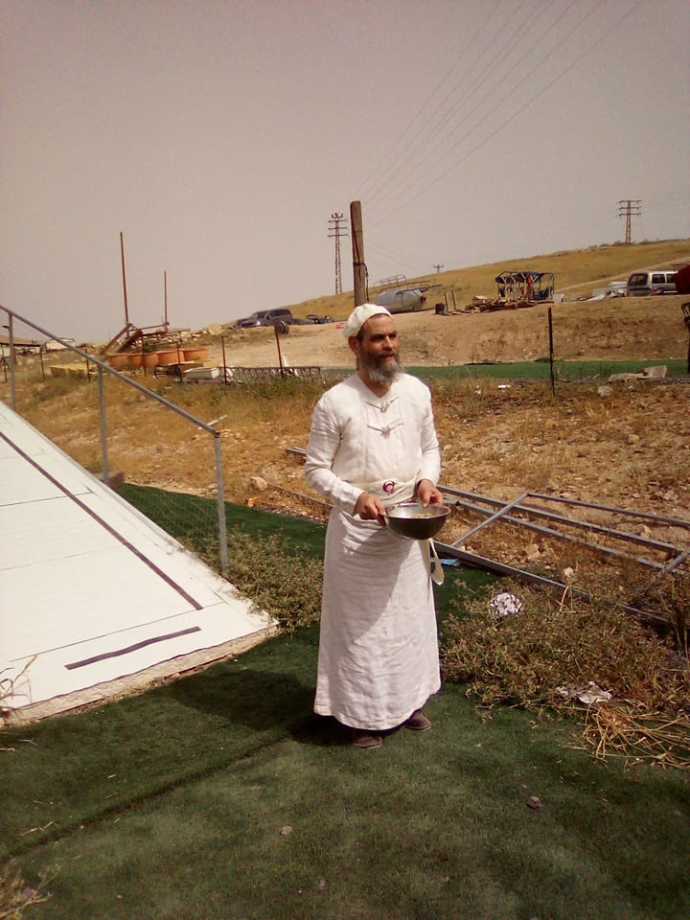As the first night of Passover ended on Saturday night, a group of people went out to a field in southern Israel to perform a Temple ritual known as the “Omer wave offering.”
The event was organized by Rabbi Hillel Weiss, the spokesman for the nascent Sanhedrin.
The Omer offering was a grain sacrifice that was brought to the temple in Jerusalem during Temple times.
The complete ritual took place in three stages in three separate locations, requiring almost 24 hours to complete. The barley was harvested from a field in Beit Kama, a kibbutz in the northern Negev. A non-religious farmer has been faithfully planting and tending the field specifically for the ritual for the past nine years since the developing Sanhedrin began performing the ritual.
The field must be easily accessible to the road as the ritual is performed at night and this year, was attended by about 50 people including families with children. It was carried out in a holiday spirit with musicians accompanying the harvest.
Weiss noted that this was in keeping with the tradition of the Omer ceremony which, in Temple times, was carried out by the common people with great joy.
Weiss noted that this year is a shemittah (sabbatical year) and harvesting is forbidden.
“Even so, all of the agricultural acts which were normally forbidden in the shemittah were permitted for the Temple service,” Weiss explained.
The ritual is explicitly mandated in the Bible:
He shall elevate the sheaf before Hashem for acceptance on your behalf; the Kohen shall elevate it on the day after the Shabbat. (Leviticus 23:11)
Weiss emphasized the role of the farmer in the Omer ceremony:
“He not only plants the barley and tends it, but after we take what we require for the Temple service, he must take care to leave the peah, the fringes of his field for the poor,” Weiss said. “The two mitzvot (Biblical commandments) are integrally connected, implying that the bounty of the land of Israel is the product of our adherence to the Biblical commandments which include the Temple and tzedakah (charity).”
Approximately three se’ah (approximately 6.5 gallons) of barley stalks are harvested at night as the holiday ends. The barley was taken to the courtyard adjacent to King David’s Tomb on Mount Zion where it was beaten and winnowed. This too was carried out with singing and music.
“The Omer is a part of the heritage of King David through his grandmother, Ruth the Moabite, who harvested the peah in the field of Boaz,” Weiss said. “Even though King David is not a Kohen (priest), the return of the Davidic dynasty and the building of the Third Temple with the return of the Temple service must happen together.

The barley was then taken to Mitzpeh Jericho where a full-size model of the altar stands and a group of Kohanim, led by Rabbi Baruch Kahane acting as the High Priest, were waiting in their Biblically mandated clothes. The kernels were roasted and milled, and the flour was sifted through 13 sifters. One-tenth was removed and mixed with oil, and a handful of frankincense was placed upon it. It was waved in the eastern portion of the courtyard in all four directions—up, down, right and left. It was then brought close to the tip of the southwest corner of the altar. A handful of the meal was taken and offered on the altar’s pyre. The remainder was eaten by the priests.
Weiss emphasized that the Omer ritual can be carried out even without the Temple or being on the Temple Mount, but that the group is equipped to establish the ceremony on the Temple Mount when relevant.
“A Temple structure is not necessary for the Temple service,” he explained. “We have prepared everything that is necessary; priests and their clothing, vessels and implements, silver trumpets. To actually perform any of the sacrifices, we need an altar and we have one prepared that is transportable. It can be taken to the Temple Mount and assembled in under one hour. After the ceremony, it can be disassembled and stored away for the next ritual.
“The only thing preventing us from reinstating the Temple service is the Israeli government,” he continued. “We prepared the Omer with this in mind. If the government decided sometime during the day to permit the Omer ceremony to be performed on the Temple Mount, we would then be required by Torah law to move the ceremony to its proper place and it would be entirely valid, just like in the days when the Temple stood.
“Since the government did not make that decision, the ceremony became a reenactment for the purposes of educating the people and the Kohanim,” Weiss concluded.
The Omer ceremony is important enough that the harvest, an activity normally prohibited on Shabbat, would even take place on the Sabbath.
Only after this offering was brought could the grain that had taken root prior to the time of the offering be eaten.
According to the Talmud (Kiddushin 38a), it was on the day of the Omer offering, the sixteenth of Nissan, that the Israelites ran out of manna after it ceased to fall following the death of Moshe. At that point, the Jews began to eat from the fruits and grains of the land of Israel.
